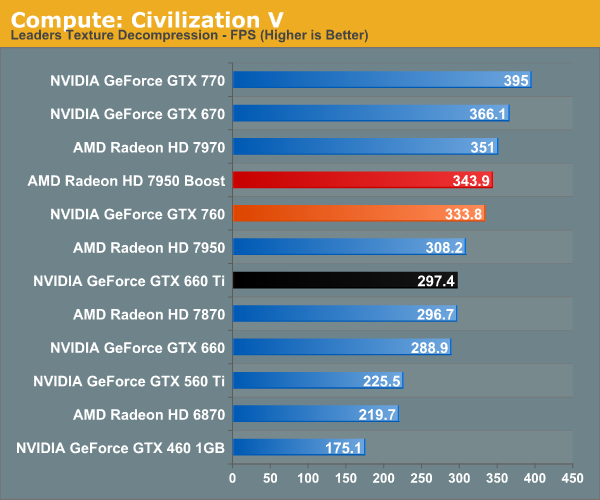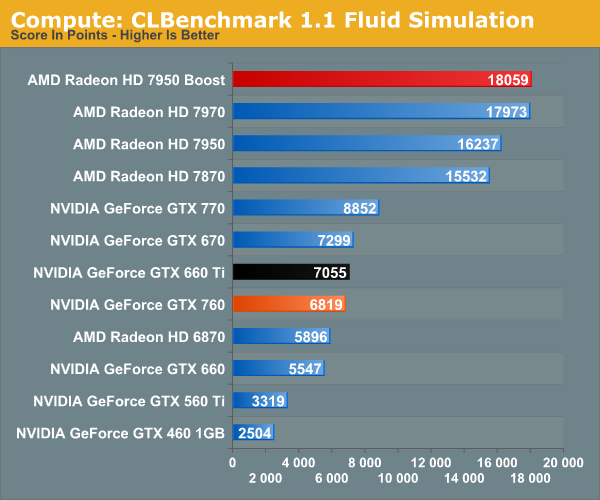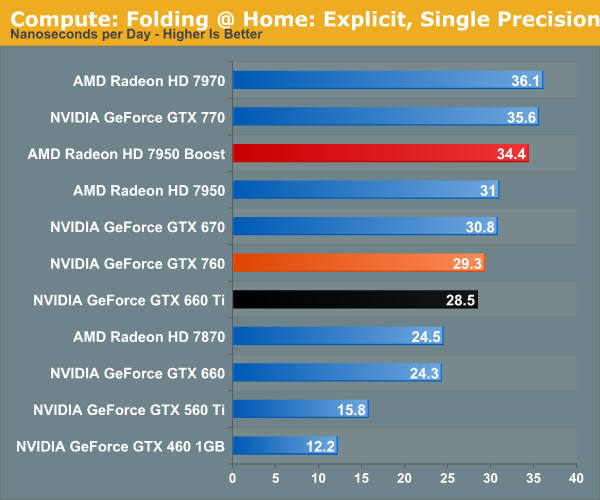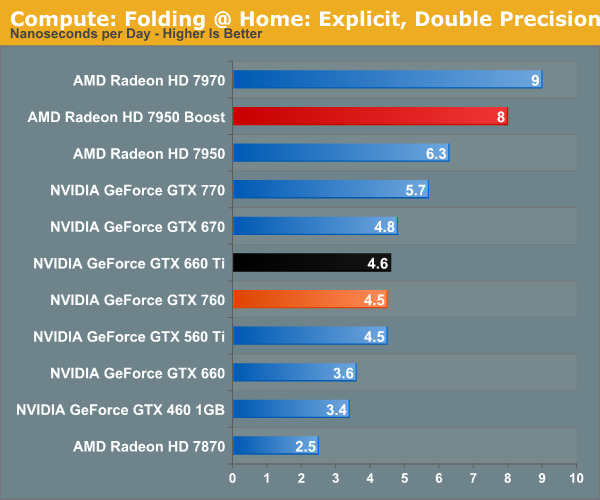NVIDIA GeForce GTX 760 Review: The New Enthusiast Kepler
by Ryan Smith on June 25, 2013 9:00 AM ESTCompute
Jumping into compute, we aren’t expecting too much here. Outside of DirectCompute GK104 is generally a poor compute GPU, and the loss of an SMX relative to the GTX 660 Ti isn’t doing the GTX 760 any favors here. By all appearances the GTX 760 is even more of a pure gaming card than the GTX 660 Ti was.
As always we'll start with our DirectCompute game example, Civilization V, which uses DirectCompute to decompress textures on the fly. Civ V includes a sub-benchmark that exclusively tests the speed of their texture decompression algorithm by repeatedly decompressing the textures required for one of the game’s leader scenes. While DirectCompute is used in many games, this is one of the only games with a benchmark that can isolate the use of DirectCompute and its resulting performance.

Civilization V once more validates that NVIDIA’s DirectCompute performance is generally up to snuff in this case. The fact that the GTX 760 is ahead of the GTX 660 Ti by any degree took us by surprise at first, but we’re likely looking at a scenario where the wider memory bus and/or larger L2 cache of GTX 760 offset some of the general compute gap.
Our next benchmark is LuxMark2.0, the official benchmark of SmallLuxGPU 2.0. SmallLuxGPU is an OpenCL accelerated ray tracer that is part of the larger LuxRender suite. Ray tracing has become a stronghold for GPUs in recent years as ray tracing maps well to GPU pipelines, allowing artists to render scenes much more quickly than with CPUs alone.

Luxmark is entirely about compute performance, and as a result this is an exceptionally poor showing for the GTX 760, with the GTX 660 Ti having no trouble besting it.
Our 3rd benchmark set comes from CLBenchmark 1.1. CLBenchmark contains a number of subtests; we’re focusing on the most practical of them, the computer vision test and the fluid simulation test. The former being a useful proxy for computer imaging tasks where systems are required to parse images and identify features (e.g. humans), while fluid simulations are common in professional graphics work and games alike.


Breaking down our CLBenchmark results, the computer vision test has frequently favored raw clockspeed over total shader throughput, which gives the GTX 760 an interesting advantage here. It’s capable of easily leaving the GTX 660 Ti in the dust and even edge out the GTX 670. Of course this is still less than 2/3rds the performance of even the slowest AMD GCN card, reflecting AMD’s superior computer performance.
The fluid simulation is especially brutal in that regard. Once again shifting back to an almost complete reliance on shader throughput, GTX 760 slightly trails GTX 660 Ti, never mind the nearly three-fold difference between it and the 7950B.
Moving on, our 4th compute benchmark is FAHBench, the official Folding @ Home benchmark. Folding @ Home is the popular Stanford-backed research and distributed computing initiative that has work distributed to millions of volunteer computers over the internet, each of which is responsible for a tiny slice of a protein folding simulation. FAHBench can test both single precision and double precision floating point performance, with single precision being the most useful metric for most consumer cards due to their low double precision performance. Each precision has two modes, explicit and implicit, the difference being whether water atoms are included in the simulation, which adds quite a bit of work and overhead. This is another OpenCL test, as Folding @ Home has moved exclusively to OpenCL this year with FAHCore 17.


Unlike some of our other compute benchmarks, the GTX 760 doesn’t fare too poorly here when it comes to single precision. However it’s still notably behind the 7950B in this case. And with double precision it’s no contest.
Wrapping things up, our final compute benchmark is an in-house project developed by our very own Dr. Ian Cutress. SystemCompute is our first C++ AMP benchmark, utilizing Microsoft’s simple C++ extensions to allow the easy use of GPU computing in C++ programs. SystemCompute in turn is a collection of benchmarks for several different fundamental compute algorithms, as described in this previous article, with the final score represented in points. DirectCompute is the compute backend for C++ AMP on Windows, so this forms our other DirectCompute test.

As another compute throughput bound benchmark, the GTX 760 is essentially tied with the GTX 660 Ti. This benchmark is somewhat memory bandwidth sensitive, which is why the GTX 760 doesn’t outright lose to the GTX 660 Ti here.










110 Comments
View All Comments
Ryan Smith - Tuesday, June 25, 2013 - link
Going by my chart, I have the GTX 760 winning in 7 of 10 games (all but DiRT, Hitman, and Crysis 1) at our highest 1080p quality settings, which is where I'm focusing on for a card this expensive. Of those magnitude matters; most of those GTX 760 wins are in the double digits, so the average does indeed end up being 8%As for frametimes, the idea is that we would normally include them. That said this review left us crunched for time; I would have likely needed to drop the Fermi cards to make time. With that in mind, there's absolutely nothing interesting going on with single-GPU frametimes right now with the games we use. The only place NVIDIA still differ are under multi-GPU scenarios.
Zstream - Tuesday, June 25, 2013 - link
Shouldn't we be using the median instead of average?ewood - Tuesday, June 25, 2013 - link
median, mean and mode all show very different things. you should have all three to draw detailed conclusions, however if only one is available i would personally prefer it be the mean.ShieTar - Thursday, June 27, 2013 - link
With a sample size of 10, the median would not be a very helpful information. To be honest, the mean is not all the important either. The distribution of performances is not all that random when comparing nVidia and AMD, but rather there are significant preferences for one architecture by each game.So everybody on the lookout for a new card should mainly be checking for a benchmark specifically on the game he/she spends the most time with. For this reason, I would love to see the benchmarks on Anandtech include the name of the engine for each game (if it is a licensed one), and maybe provide some handy reference to figure out what other games use the same reference.
And personally, as a player who does not play reaction-based games like shooters or racers a lot, I would love AT to re-introduce a BioWare and/or Blizzard title back into their benchmark-zoo. Even if those are not extremely new or demanding, I think they still have a high importance for a large number of players who don't care much to shoot virtual people in their virtual faces.
MarcVenice - Tuesday, June 25, 2013 - link
I see, I counted Sleeping Dogs as a win for the HD 7950 as well, considering the minimum fps is a bit higher. Thanks for the reply, I agree that if all is well with frametimes in a certain game, fraps is still a good way to measure raw rendering power.JeBarr - Tuesday, June 25, 2013 - link
Most multi-GPU users are reporting that the frame time issue mostly exists for 2-way SLI and Quad SLI. It seems that 3-way SLI or Dual GPU single slot SLI is the way to go for gamers concerned about the stutters. I'm not sure about 4-way SLI though, since I don't bother with it anymore. I can however, confirm that in my personal experience a single GPU or 3-way SLI is mostly unaffected.draknon - Tuesday, June 25, 2013 - link
This seems like a good spot to upgrade from my 460gtxEzioAs - Tuesday, June 25, 2013 - link
Yeah, it is. My original plan was to get the GTX 760, but Nvidia delayed it and I wasn't going to wait anymore, so I went and bought the GTX 660.DanNeely - Tuesday, June 25, 2013 - link
I'm tempted to upgrade to it from my 560 when I built a Haswell box later this summer and put the difference between it and a higher end card toward a better SSD, etc and then get a top end Maxwell based card next year.I'm a bit concerned about ending up in the same trap I did last time though. I bought the 560 as a stopgap replacement in Jan 2012 after stupidity killed my 5870, with the intent of upgrading to a GK100 based card in half a year or so only to have nVidia fumble its top end launch.
omarccx - Tuesday, June 25, 2013 - link
It seems like an even greater upgrade from my HD4000. :x